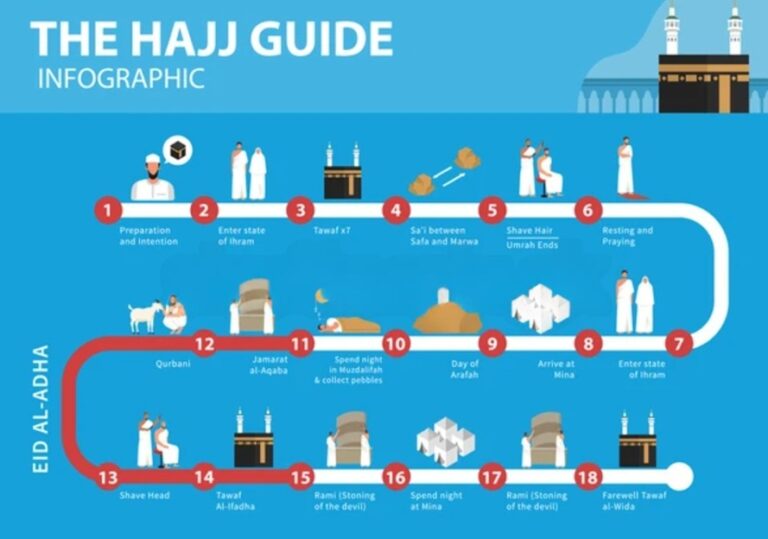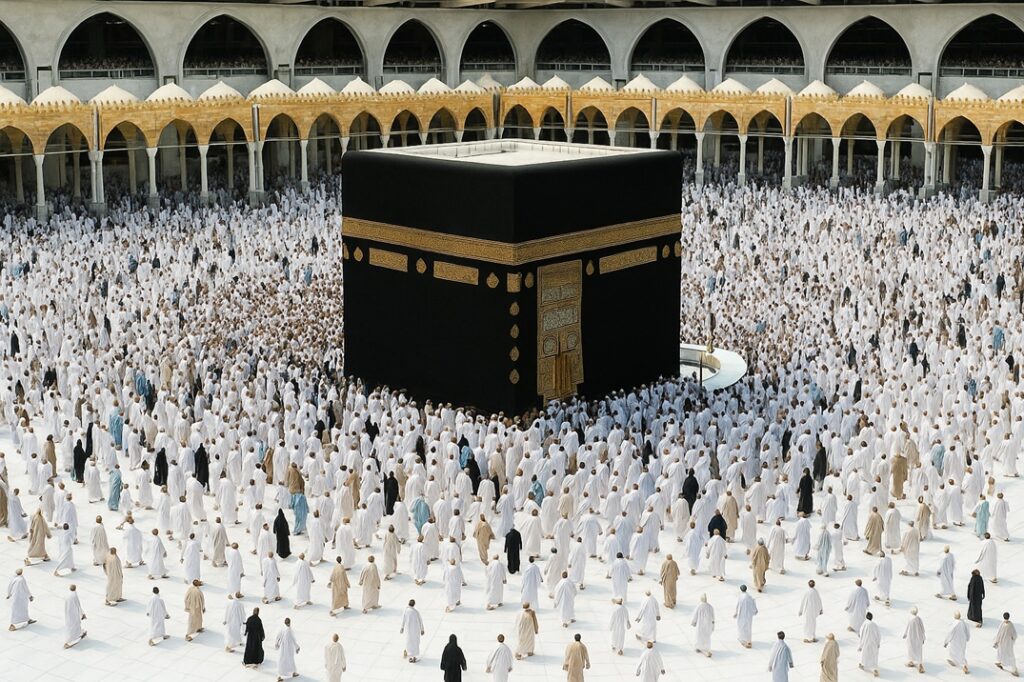Hajj and Eid Al-Adha:
A Time of Spiritual Renewal and Sacrifice
As the sacred spirit of Hajj / Eid al-Adha fills hearts across the globe, millions have already celebrated it today, June 6th. Yet for countries like Pakistan, India, Malaysia, and Bangladesh, the celebration awaits—just a night away. With anticipation in the air and faith in our hearts, the NetGlowz team invites you on a heartfelt journey into the history, meaning, and timeless traditions of Hajj and Eid al-Adha—a day that honors sacrifice, devotion, and the beauty of giving. Let’s begin this soulful reflection together.
Every year, millions of Muslims around the world come together in a remarkable display of faith, unity, and devotion during the sacred month of Dhul-Hijjah. Two significant events mark this spiritual season—Hajj, the annual pilgrimage to Makkah, and Eid ul-Adha, the Festival of Sacrifice. More than just rituals and festivities, these sacred occasions serve as deep reflections of surrender, modesty, and empathy in the Islamic faith.
The Journey of Hajj: A Pillar of Islam
Hajj is one of the Five Pillars of Islam, making it a central act of worship for Muslims. Every adult Muslim who is physically and financially able is required to perform Hajj at least once in their lifetime. It takes place in the Islamic month of Dhul-Hijjah, specifically between the 8th and 12th days of the month.
The pilgrimage involves a series of rituals that commemorate the actions of the Prophet Hazrat Ibrahim (Abraham), his wife Hazrat Hajara , and their son Hazrat Ismail . These rituals include:
- Tawaf: The sacred act of circling the Kaaba seven times, binds every Muslim’s heart to the Divine. Each step around the holy House of Allah feels like a whisper of love, a journey of the soul drawing closer to its Creator. With every round, we shed our burdens, our hearts beating as one with millions, united in faith and devotion. This is our homecoming, where tears and prayers create a bond of hope, connecting us to the eternal embrace of Islam.
- Sa’i: represents Hazrat Hajara’s determined effort as she ran between the hills in search of water for her infant son, Hazrat Ismail (A.S), in the vast and barren desert. The Sa’ee ritual, where pilgrims walk seven times between Safa and Marwah hills, honors her strong faith and effort. Each step reminds pilgrims of her trust in God, who gave her the Zamzam spring. This touches hearts—mothers feel her worry, fathers her strength, and all share her hope. It teaches us that faith can overcome fear, bringing people closer through love and trust.
- (Wuquf e Arafa)– Standing at Arafat: The sacred gathering on the plain of Arafat, is where Muslim hearts pour out in prayer and tears. Standing together, pilgrims seek Allah’s mercy, their souls open under the vast sky. Each dua rises like a flame, carrying hopes and sorrows to the Divine. This is the moment of closeness, where faith feels alive, uniting millions in love and forgiveness. On this blessed Day of Arafa, whether rich or poor, all stand equal in Ihram before Allah, bowing with humility, knowing He alone holds all power. This sacred place and day mean so much to Muslims, for we believe that on the Day of Judgement, we will rise again and will be standing at Arafat before Allah for the final reckoning.
- Muzdalifah: In Muzdalifah, pilgrims gather pebbles under the starlit sky, each stone a symbol of defiance against evil, echoing Prophet Ibrahim’s courage in rejecting Satan. As they throw these pebbles at the pillars, hearts pound with faith, casting away inner doubts and temptations. Each stone cast symbolizes a timeless connection to resilience, reaffirming a pilgrim’s commitment to resist evil for the sake of Allah. Tears fall, hands tremble, and souls unite in this sacred struggle, feeling the power of righteousness triumph over darkness, connecting hearts across generations in devotion.
- Animal Sacrifice / Qurbani : The animal sacrifice during Eid ul-Adha stirs every Muslim’s heart, echoing Prophet Ibrahim’s unshakable trust in Allah. Ready to give up his beloved son, Ismail, for God’s command, Ibrahim’s faith was rewarded with a ram instead. As we offer this sacrifice, our hands tremble with gratitude, hearts heavy with awe at such devotion. Each act renews our bond with Allah, a reminder to surrender our desires for His will.
Hajj is a deeply humbling experience. Pilgrims wear simple white garments called Ihram, symbolizing equality before God, stripping away distinctions of wealth, status, and nationality. It is a time for self-purification, repentance, and a fresh spiritual start.

Eid ul-Adha: The Festival of Sacrifice
Eid ul-Adha, also known as Bakra Eid or Qurbani Eid, is celebrated on the 10th day of Dhul-Hijjah, This occasion honors Prophet Ibrahim’s readiness to offer his son Ismail in sacrifice, embodying complete obedience to the command of Allah. However, before the sacrifice could take place, God provided a ram as a substitute, thus sparing Ismail’s life.
To honor this moment of unwavering faith, Muslims around the world perform Qurbani (sacrifice) by slaughtering an animal—typically a goat, sheep, cow, or camel. The meat is then distributed in three parts:
- One-third for the family
- One-third for relatives and friends
- One-third for the poor and needy
This act of giving and sharing reinforces the values of compassion, generosity, and community.
Spiritual Significance
Both Hajj and Eid ul-Adha hold deep spiritual meanings. Hajj is not just a physical journey to Makkah, but a transformative inner journey. It’s about cleansing the soul, seeking forgiveness, and reconnecting with the Creator. Many pilgrims describe it as a life-changing experience that instills greater humility, patience, and gratitude.
Eid ul-Adha imparts powerful lessons on surrendering to divine will, staying devoted, and embracing the spirit of selfless sacrifice. It reminds Muslims that faith sometimes requires personal sacrifice and that true devotion means trusting God’s wisdom, even when it challenges us deeply.
A Time for Unity and Reflection
Hajj is unique in that it brings together Muslims from every corner of the globe—different cultures, languages, and backgrounds—united by one purpose: to worship Allah. The sea of white-clad pilgrims moving together around the Kaaba is a powerful symbol of Islamic unity and brotherhood.
The morning starts with a unified prayer gathering, setting the tone for a day filled with warm exchanges, communal feasts, and generous giving. For Muslims, it’s an opportunity to reunite with family, support those in need, and nurture community ties.
Final Reflections: Submitting to Allah with Gratitude
Hajj and Eid ul-Adha are more than religious events—they are profound moments of spiritual renewal. These sacred days inspire Muslims to live their faith through action, standing in solidarity with those in need and embracing humility, gratitude, and compassion. Whether standing on the blessed plains of Arafat or celebrating Eid with loved ones at home, the essence of these moments touches the heart deeply. In a world often filled with division and distraction, Hajj and Eid ul-Adha call us back to the heart of our faith: love for Allah, service to others, and a life of justice and mercy. As Dhul-Hijjah draws near each year, Muslims worldwide eagerly await these blessed days, not just to perform rituals but to reconnect with the timeless values that shape our souls. We pray that Allah accepts the Hajj of all who performed it with devotion and grants us the chance to embark on this sacred journey in the coming year. Taking this opportunity, NetGlowz wishes all its readers and subscribers a joyful and blessed Eid ul-Adha, filled with love, unity, and spiritual growth.

